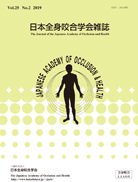To clarify the effect of occlusal interference on the masticatory movement path, a 100-μm experimental occlusal interference was applied to participants with a representative path pattern of healthy subjects, and the masticatory movement path before and after the application was analyzed. The movement of the incisal point during chewing of softened gum was recorded using MKG (Mandibular Kinesiograph K-5) before and after experimental occlusal interference (hereinafter abbreviated as interference). First, the appearance ratio of the masticatory movement path pattern before and after interference was investigated. Next, the parameters representing the masticatory movement path (opening distance and masticatory width) and its stability (lateral component of opening, lateral component of closing, and vertical component)were compared among three groups: before interference, after interference to the cuspid, and after interference to the first molar. Regarding the appearance ratio of the masticatory movement path pattern, the representative pattern of healthy subjects (pattern I or III) was remarkably high before interference but decreased after the interference was applied, and other patterns were observed. The values of the parameters representing the masticatory movement path did not significantly change before and after interference; however, those representing the stability of the masticatory movement path tended to be larger after the interference was applied than before the interference. Significant differences were observed between before and after interference for the lateral component of opening and vertical component after interference to the cuspid and for the lateral components of opening and closing after interference to the first molar. It was suggested that even an occlusal interference of only 100-μm changed the pattern of the masticatory movement path and made it unstable.
View full abstract
